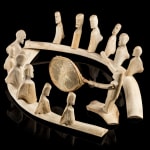LUKE IKSIKTAARYUK (1909-1977) QAMANI’TUAQ (BAKER LAKE)
unsigned
ESTIMATE: $20,000 — $30,000
PRICE REALIZED: $20,000.00
Further images
Although many traditional Inuit drum dances were performed at important community events, festivals, and song contests, Iksiktaaryuk's drum dance scenes probably depict shamanic séances. (The artist’s other favourite subjects were single figures depicting standing or flying shamans.) These séances would have likely spiritually charged communal gatherings rather than festivities. As Jean Blodgett writes in The Coming and Going of the Shaman: "The solemnity of the performance, the absolute and evident trust and belief of the officiating shaman and his audience, and concerted singing of hymns and rhythmic beat of the drum all combined to give the séance the dignity of a religious service. [1] Drum dances were actively suppressed or discouraged by Christian missionaries, and while they went underground in some communities they essentially disappeared in others. Drum dancing has in recent decades undergone a revival but most performances, including those held in the South, are secular and festive in nature.
The standing drummer in this fine example is likely a shaman-drummer. He is encircled by a ring of seated or kneeling female a-ja-ja singers accompanying the hypnotic beat of the drum. (An unseen audience of men and women would have been seated or standing in a second, outer ring.) Iksiktaaryuk, who worked almost exclusively in caribou antler, makes sparing but effective use of the natural shapes of his chosen material. Particularly brilliant is his use of the natural protrusions of antler to represent the women’s amautiq pouches, which contrasts with the more upright and columnar figure of the drummer. The figure of the drummer is by necessity more complex, but minimally so. His left arm connects with the wooden drum handle, which is lashed to the wooden rim with sinew. As the focal point of the composition, the drum itself is fashioned with remarkable precision; amazingly, Iksiktaaryuk uses caribou heart tissue to approximate the relative thickness of a real drum’s scraped hide more closely. In contrast the right arm is treated minimally, with a simple groove indicating the beater extending from it. Another brilliant touch is the way the artist has split a single curved shaft of antler in two to create the lovely wishbone-shaped base for the singers.
Curator Norman Zepp chose Iksiktaaryuk as one of seven artists for his landmark Pure Vision exhibition. Zepp rightly sees these artists as having a “strength and purity of vision” that epitomizes the “minimalism” often seen in the art of the Keewatin [Kivalliq] Region; a “vitality and immediacy of expression common to art stripped of superfluous detail and reduced to its essential form.” [2] The spirit of Iksiktaaryuk's pared-down antler works contrasts with the more playful and "folk art" sensibility of other Inuit artists who have specialized in antler carving. For very similar examples of drum dances by the artist see Pure Vision, cat. 79, p. 136; and Jean Blodgett, Grasp Tight the Old Ways (Toronto: AGO, 1983), cat. 12, p. 47.
1. Jean Blodgett, The Coming and Going of the Shaman: Eskimo Shamanism and Art (Winnipeg Art Gallery, 1978), p. 140.
2. Norman Zepp, Pure Vision: The Keewatin Spirit (Regina: Norman Mackenzie Art Gallery, 1986), p. 35. See the section on the artist, pp. 130-139.References: For a discussion of Iksiktaaryuk’s sculpture see Norman Zepp, Pure Vision: The Keewatin Spirit (Regina: Norman Mackenzie Art Gallery, 1986); for works see pp. 132-139; in particular cats. 78-79. See also Winnipeg Art Gallery, The Zazelenchuk Collection of Eskimo Art (Winnipeg: Winnipeg Art Gallery, 1978), cat. 10, p. 21; and Jean Blodgett, The Coming and Going of the Shaman: Eskimo Shamanism and Art (Winnipeg: Winnipeg Art Gallery, 1978), cat. 89, p. 146. For similar works by the artist see George Swinton, Sculpture of the Inuit (Toronto: McClelland & Stewart, 1992 edition only), fig. 860, p. 258; Gerald McMaster, ed., Inuit Modern: The Samuel and Esther Sarick Collection, (Toronto: Art Gallery of Ontario, 2010), pp. 132-133; Ingo Hessel, Arctic Spirit: Inuit Art from the Albrecht Collection at the Heard Museum (Vancouver: Douglas & McIntyre / Phoenix: Heard Museum, 2006), cat. 154, p. 184; Art Gallery of Ontario, The People Within: Art from Baker Lake (Toronto: Art Gallery of Ontario, 1976), cat. 77, unpaginated. See also First Arts, 12 July 2020, Lot 21. See also Walker’s Auctions, 4 Nov. 2012, Lot 106.
Provenance
Waddington's, Toronto, June 2014, Lot 116;Acquired from the above by Norman Zepp & Judith Varga, Saskatoon, SK.
Join our mailing list
* denotes required fields
We will process the personal data you have supplied in accordance with our privacy policy (available on request). You can unsubscribe or change your preferences at any time by clicking the link in our emails.












